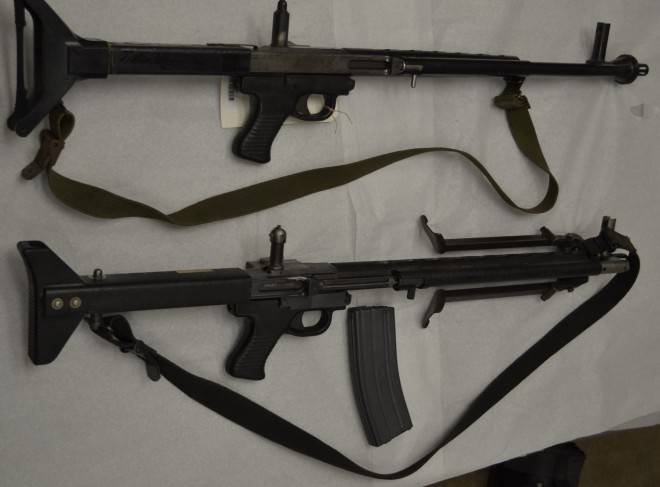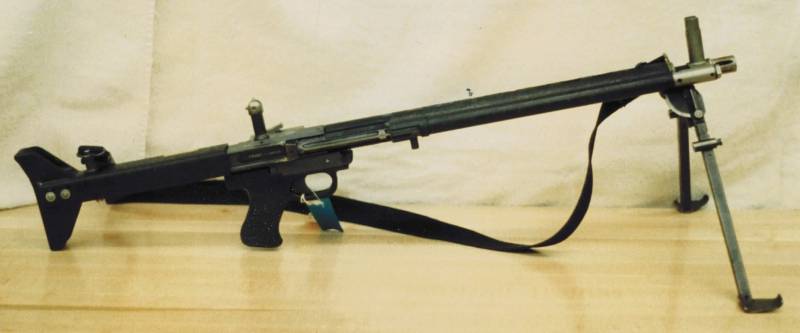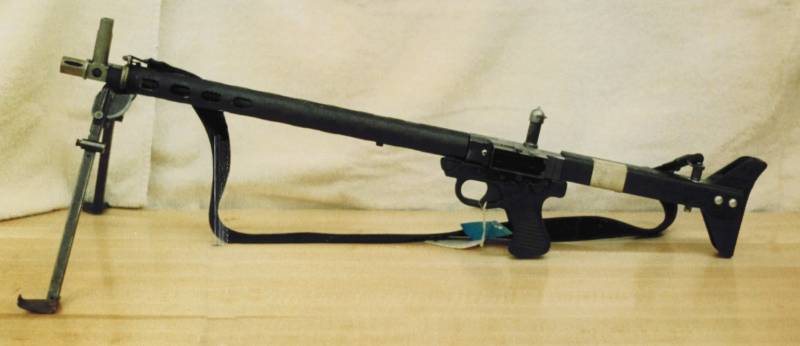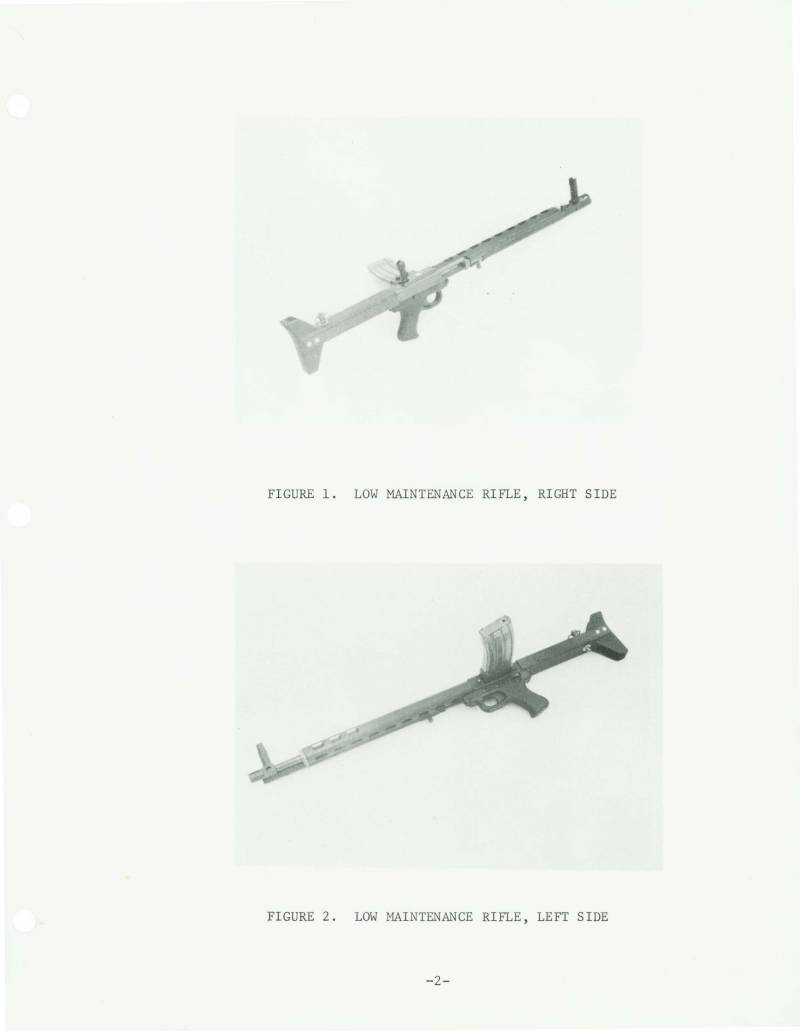TRW Low Maintenance Rifle automatic rifle (USA)
At the beginning of the seventies, Pentagon experts proposed an original idea, which allowed to get the desired results in the field of military-technical cooperation with foreign countries, but at the same time drastically reducing the cost of assistance for them. Until now, in the order of assistance, weapons and equipment of armed types, often distinguished by high prices, were transferred to friendly armies or armed formations in order. Especially for the implementation of such new supplies have proposed to create the most simplified and cheap, but sufficiently effective automatic rifle.
The new project was launched in 1971 year, and soon the basic requirements for advanced weapons were identified. First of all, the rifle should have a minimum cost due to the simplicity of design and production. At the same time, the product had to be distinguished by high performance characteristics. The first recipient of the new rifles were to be the troops of South Vietnam, who had to fight in a difficult climate. As a result, the weapon should have been resistant to high humidity and other characteristic factors. Finally, it was necessary to simplify the use of weapons so that poorly trained fighters could handle them. In addition, it allowed to reduce the risks associated with incorrect logistics and the lack of timely delivery of the necessary materials.
The last requirement for a rifle was made in the name of the entire program. A new model of weapons received a working designation Low Maintenance Rifle - "Rifle with a reduced need for maintenance." For convenience, the abbreviation LMR was used. Since the rifle was not put into service, it was not given the official army designation, and it remained in history under the working title.
Several preliminary projects were submitted to the LMR competition, and soon the customer chose the most successful one. According to Pentagon experts, the project from TRW Systems Corp. looked the best. (formerly Thompson Ramo Wooldridge). It is curious that the main field of activity of this organization at that time was space technology. However, this did not prevent her from trying her hand in the field of small arms. For several years, TRW has developed and proposed several new models of this kind, including a simplified rifle.
TRW's Low Maintenance Rifle project was based on a few key ideas. To simplify the design, it was planned to use a number of proven engineering solutions, and in addition, it was necessary to abandon certain functions. Production costs had to be reduced by using the cheapest materials, the simplest technologies, as well as some off-the-shelf components. Requirements of operational nature decided to fulfill with the help of certain coatings of all the main parts of the structure.
The main, though not the largest part of the new weapon was the receiver, to which all other parts joined. A tubular barrel casing with perforations and a gas engine was attached to the front of it. On the extended shank of the box was asked to install the butt. One of the ways to simplify the design was the so-called. linear layout. The housing and receiver assembly were actually a long metal tube of variable cross section with some external devices. It consistently placed the barrel and the movable gate. Instead of the traditional back cover on the receiver was placed the butt of a special design. Under the front of the receiver was a small casing with details of the firing mechanism.
The rifle received a rifled barrel caliber 5,56 mm long 493 mm (88 calibers). The chamber was designed for NATO standard intermediate ammunition 5,56x45 mm. On the right side of the barrel, near the muzzle, there was a gas outlet. It connected the barrel with the gas engine cylinder, which was fixed on board the barrel cover. Inside the cylinder was a piston with a long stroke, as well as its return spring. This arrangement of the gas engine allowed freeing up space inside the receiver and simplifying the design of the weapon.
The gas piston of great length and the slide frame consisted of one major detail. Its front cylindrical section received the energy of powder gases, and the flat rear one was responsible for driving the shutter. It also had a cocking handle. And, like some other automatic rifles, the handle was moved forward relative to the bolt. Between the bolt carrier and the bolt was placed a plate cover that protected the receiver from dirt.
The receiver had a square cross-section, which affected the shape of the shutter. The latter was made in the form of a massive block with rounded side surfaces and a number of different grooves and holes. A spring-loaded drummer moved in the longitudinal channel of the bolt. In the front third of the shutter, above and below, a pair of locking rollers was provided. When moving the bolt forward, they had to slide out of it and fit into the grooves of the receiver.
TRW LMR rifle was not the most familiar means of ammunition, which, however, allowed to simplify the design of the weapon. On the left side of the receiver located a small horizontal receiving shaft shop. The cartridges from the latter were supposed to flow to the line of discharging, and it was proposed to throw the sleeves through a window in the right wall. When the shutter was moved forward, the window was blocked by a movable lid, which prevented dirt from entering. In the basic version, the prospective rifle was supposed to use an intermediate cartridge 5,56x45 mm and standard magazines for the M16 rifle.
The gunners from TRW Systems considered that a full firing mechanism with the ability to select a fire mode would make the weapon too complicated and expensive. In this regard, the rifle was supposed to shoot in bursts and with the open bolt, and it was proposed to take fire controls from the finished sample. The source of the necessary components has become a serial machine gun M60. He borrowed the entire fire control unit in the form of a casing with a handle and the details of the trigger mechanism.
The T-shaped system with the trigger, the sear and the safety device was placed directly under the receiver and secured with the help of standard pins. USM before the shot could block the bolt in the rearmost position. Pressing the trigger led to its displacement forward, sending a new cartridge and a shot. There was no fire interpreter, and therefore only automatic fire could fire a weapon. However, with proper skill and training, the fighter could shoot single.
Interestingly, the LMR rifle received two non-automatic fuses at once. One was part of the trigger and blocked the descent, and the second was part of the gas engine. In the forward position of the bolt, the reload knob was rotated clockwise and entered the groove holding it in place. This blocked the movement of the piston and bolt group.
Experienced rifles were equipped with simple sights. Cylindrical tubular bases were placed above the muzzle of the barrel and on the receiver. They, in turn, were the front sight and sight of a simplified design. On the rear support set semicircular cap with reversible whole. In one position he provided aiming at distances up to 300 yards, in the other - from 300 to 500 yards.
"Reduced maintenance rifle" differed in very specific ergonomics. It was proposed to hold it with a plastic pistol grip and a cylindrical barrel casing. A special butt was also developed. It was made in the form of a square tube with a stamped shoulder rest from a pair of vertical plates. The butt tube was put on the stem of the receiver and fixed with a pin. On the pin there was a loop for a belt. The second ring was placed near the barrel.
The customer doubted the ability of future operators to provide proper care for their weapons, and this should have been taken into account at the design stage. To reduce maintenance requirements have applied a significant number of chrome parts. Such a coating protected the barrel, the bolt group and other aggregates in contact with the powder gases from the powder deposit. Some parts instead of the traditional liquid lubricants proposed to apply a film of dry lubricant. This coating did not require special maintenance. After the 2000 shots, it was proposed to scrape off the remnants of the lubricant and put a new film on them.
With a prospective cheap rifle, various additional devices could be used. At the front of the gas tube, to the right of the front sight, it was proposed to mount the M6 type bayonet. In addition, the rifle could be equipped with a folding bipedal bipod. Such a product was attached immediately behind the muzzle cut. During the tests, the authors of the project also experimented with different designs of self-contained devices, flame arresters and brakes-compensators.
The TRW LMR rifle assembly had an 34,3 inch length (1045 mm). After installing the bayonet, the length increased to 40 inches (1,22 m). The weapon turned out not too high, but the lateral location of the shop’s mine led to an increase in its width. A rifle without ammunition weighed 7,26 pounds (3,3 kg). The equipment store had a mass of slightly less than 350.
A gas engine and a single-mode trigger made it possible to get good combat performance. A relatively long barrel ensured the acceleration of the bullet to 990 m / s. The technical rate of fire was determined in 450 shots per minute. In practice, the maximum rate of fire was limited to 120 shots per minute. The need for a long fire with limited ammunition further reduced the rate of fire. The maximum firing range exceeded 2,25 km, but the effective range was limited to just 460 m.
In terms of operating principles, the Low Maintenance Rifle automatic rifle resembled some machine guns. The specific layout of the weapon also forced to recall other types of weapons of the past, the development of which also took into account the need for maximum simplification and cheapening.
Having placed the magazine in the receiver, the shooter had to pull the gas piston handle towards himself and bring it to the extreme rear position, after which the bolt was fixed with a sear, and the piston returned to its original place. When you press the trigger, the bolt was released, went forward, sent the cartridge and locked the barrel. A drummer moving by inertia ignited a cartridge. Powder gases from the barrel bore into the gas engine and forced the piston to go back, shifting the bolt group. Depending on the position of the trigger or the whisper, the rifle made a new shot or became a platoon.
One of the main goals of the project was to reduce the cost of a serial rifle. At the design stage, it was determined that in mass production one TRW LRM product would cost the customer 130 dollars - less than 800 dollars at current prices. For comparison, the M16 serial rifle at that time cost about 300 dollars.

LMR rifle with a bayonet. Photo Modernfirearms.net
Designing a new weapon took only a few months and ended in the same 1971 year. Soon, TRW Systems began producing experienced rifles, which should have been tested and presented to the military. It is known that the prototypes of the new weapons were definitely different from each other. As the finished products were checked and the project was refined, various minor changes were made to the design of the new rifles. In addition, various options were tested. The main ideas, technologies and approaches did not change and were common to all prototypes.
At least one of the prototypes of the TRW LMR product was designed for a special cartridge. Instead of a standard intermediate cartridge with a “traditional” bullet, he had to use XM126 ammunition with a subcaliber swept bullet. However, this version of the rifle was not too different from the base.
Development work on the “reduced maintenance rifle” theme lasted for about two years. The rifle was tested and refined until the 1973 year, when the military decided to abandon an interesting project. With all its advantages, the TRW Low Maintenance Rifle project of a cheap and simple rifle no longer made sense. Changing the military-political and strategic situation, as well as the emergence of reasonable alternatives put an end to these weapons.

A pair of museum rifles. Products differ in the design of some parts and the composition of additional equipment. Photo by Thefirearmblog.com
In 1973, the outcome of the current war was already clear, and the United States began to withdraw an army from Vietnam. In the foreseeable future, new armed conflicts were not foreseen, and the US armed forces did not seem to have to supply the Allies with mass and cheap weapons of a simplified design. In addition, by this time, the arms industry had completed the adjustment of the M16 rifle, and now it could be produced in large quantities both for itself and for foreign partners.
In such a situation, TRW Systems' Low Maintenance Rifle automatic rifle had no real future. The Pentagon decided not to waste time, effort and money on a project with a dubious future, and therefore ordered to stop work. By this time, the company-developer did not have time to perform all the required work and prepare for mass production. In two years, only a few prototypes were collected, and after 1973, the LMRs were not manufactured. Some of these items have survived and are now museum pieces.
At the heart of the LMR project was the desire to make weapons with acceptable technical characteristics, suitable for providing quick and cheap assistance to allies. Despite certain difficulties, the technical part of this problem was solved. The company TRW Systems was able to create the most simple automatic rifle, suitable for low-cost mass production. However, even before the end of the design work, the need for such weapons disappeared. The project did not lead to the desired results, but still took its place in the history of American small arms.
On the materials of the sites:
http://forgottenweapons.com/
http://modernfirearms.net/
http://guns.com/
http://thefirearmblog.com/





Information